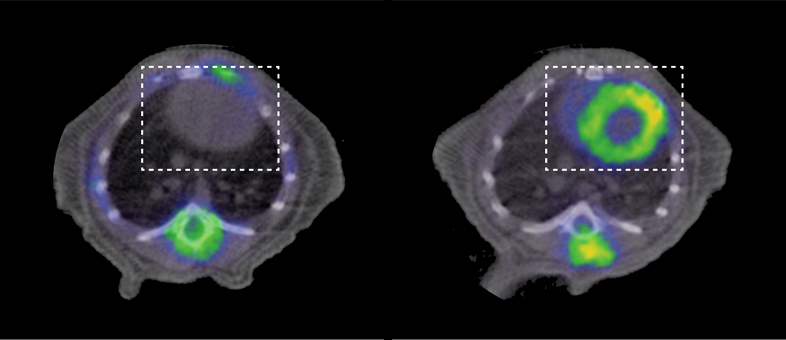CNIC researchers discover link between a mitochondrial defect and heart disease
A defect in mitochondria in the heart causes dilated cardiomyopathy, leading to heart disease and early death
- The study shows that a diet rich in fatty acids can prevent heart disease and increase survival of the mice with this condition
- Given the links between a high-fat diet and the risk of atherosclerosis, more research is needed to show if the result could translate into a benefit for a specific patient group
- The study published in Science is the fruit of a partnership between the Centro Nacional de Investigaciones Cardiovasculares Carlos III (CNIC) and the Research Institute CECAD/Max Planck in Cologne, Germany, with the collaboration of the University Hospital Fundación Jiménez Díaz and the CEU in Madrid
A defect in a vital mitochondrial process in heart cells causes a type of dilated cardiomyopathy, a heart condition that in humans leads in most cases to heart disease and premature death. The research was undertaken by teams at the Centro Nacional de Investigaciones Cardiovasculares Carlos III (CNIC) in Madrid and at the Research Institute CECAD/Max Planck in Cologne (Germany), with the participation of the University Hospital Fundación Jiménez Díaz and the CEU in Madrid. The study, published in Science, uncovers the key role of the protein YME1 in the regulation of the number, type and shape of mitocondria, and demonstrates that its absence induces a metabolic defect typical of patients with heart disease. The study also shows that metabolic strategies based on diet are sufficient to restore correct heart function, opening the possibility of future treatments for patients with this disease.
The heart is the organ responsible for pumping blood and supplying nutrients and oxygen to all organs and cells of the body. The cells charged with these functions are the cardiomyocytes, explains Jaime García-Prieto, joint first author of the study together with his counterpart in Germany, Timothy Wai. Jaime points out that correct heart function requires large amounts of energy; every day the heart burns approximately 20 times its weight in the form of ATP (the molecular energy source), beats more than 100,000 times, and pumps approximately 8000 kg of blood. Therefore any failure in the supply of energy to the heart results decreases the organ’s pumping capacity, leading to heart failure and eventually death.
The major part of the energy necessary for cellular activity is provided by mitochondria. These cellular structures act as ‘power stations’, producing energy from the metabolism of organic ‘fuels’, including sugars, lipids (fatty acids) and amino acids. Lack of a substrate or a failure in the coordinated biochemical processes of energy production has lethal consequences for the cell, and in the case of cardiomyocytes, for the patient.
A common disease
 Dilated cardiomyopathy is a relatively common disease in which the heart enlarges and loses contractile strength. In most cases, the disease causes heart failure (the inability of the heart to efficiently pump blood to meet the body’s needs), and in terminal phases a heart transplant is required to avoid death. Although the condition can develop at any age, it is most common in people aged 40 to 50 years and affects 3 to 10 per 100,000 of the general population.
Dilated cardiomyopathy is a relatively common disease in which the heart enlarges and loses contractile strength. In most cases, the disease causes heart failure (the inability of the heart to efficiently pump blood to meet the body’s needs), and in terminal phases a heart transplant is required to avoid death. Although the condition can develop at any age, it is most common in people aged 40 to 50 years and affects 3 to 10 per 100,000 of the general population.
There are currently no specific treatments, and it is therefore essential to “understand the underlying mechanisms”, explains Borja Ibáñez M.D., Ph.D., CNIC researcher, Cardiologist at the University Hospital Fundación Jiménez Díaz, and joint lead author on the study together with Thomas Langer of the Max Planck Institute.
In healthy people, cardiomyocytes consume much more fatty acids than sugars, because of the higher energy content of lipids. This situation is reversed in heart failure patients. Dr. Ibáñez explains that “To date, this was thought to be a defense mechanism, but the prolonged use of glucose by cardiomyocytes may instead be the cause of disease progression”.
The research teams used several genetic and dietary approaches to try to reverse this mitochondrial dysfunction and thus prevent dilated cardiomyopathy. One approach involved feeding a high-fat diet to mice with the mitochondrial defect. As García-Prieto explains, the goal was to “force the heart cells to consume more fatty acids than sugars, and thus ‘bypass’ the mitochondrial defect”. The researchers observed that the high-fat diet restored normal cell metabolism and that despite the presence of the mitochondrial defect the heart regained its normal function. The results of the study demonstrate that this approach impedes disease development and increases the lifespan of mice with the mitochondrial defect.
Therapeutic implications
The prevention of dilated cardiomyopathy in a mouse model by feeding a high-fat diet signals an advance in the understanding of the mechanisms involved in heart disease and has implications for the future development of treatments for this condition. Ibáñez considers that “this result confirms the need to dedicate more resources to basic research that advances knowledge of biological systems at the molecular level, in order to understand them better and thus be able to resolve the problems that arise in patients”.
Valentín Fuster, M.D., Ph.D., General Director of the CNIC warns of the need for caution in the interpretation of these results: “We know that a diet rich in fats is a threat to health because it increases the incidence of atherosclerosis. The possibility that such a diet might be beneficial in certain cases of heart disease is very provocative and attractive. However, much translational research needs to be done before these results can be considered definitive. Nonetheless, this multicenter research program should continue, and perhaps over the medium term we will be in a position to answer this question and perhaps eventually overthrow another established paradigm”.
The next step is to research the effect of dietary intervention in patients with dilated cardiomyopathy. This study will be completed over the coming years, indicates Dr. Ibáñez, thanks to CNIC projects run in partnership with specialist hospitals, such as the joint program between the CNIC and the University Hospital Fundación Jiménez Díaz in Madrid. This project, coordinated Ibañez, investigates the application and benefits in patients with heart disease and other conditions. For Fuster, “This is a clear example of the type of the collaborative and translational research favored by the CNIC, in which research groups with different interests and perspectives collaborate on clinical problems that would not be easily resolved by teams working in isolation.”
Science 4 December 2015:
Vol. 350 no. 6265
DOI: 10.1126/science.aad0116
RESEARCH ARTICLE
Imbalanced OPA1 processing and mitochondrial fragmentation cause heart failure in mice











